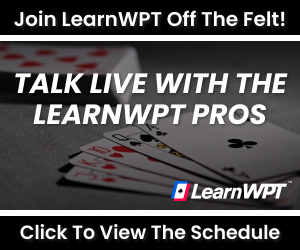Poker Quiz! Preflop With A♦K♦ Facing a 4-Bet, What Do You Do?
DECISION POINT: You are in the early stages of the $1,100 WPT Prime Championship Tournament with blinds at 300/500 and a 500 big blind ante. Most stacks are between 50-100BBs and you have 95BBs. First to act, you raise to 1,300 with A♦K♦. Action folds to the Hijack who makes it 3,800, the Big Blind cold 4-bets to 8,500, and action is back on you.
What do you do here?
PRO ANSWER: We are playing the early stages of the WPT Prime Championship at Wynn Las Vegas. The blinds are 300/500 with a 500 big blind ante. Most of the table has between 50-100 big blinds. We are dealt A♦K♦ Under the Gun (UTG) with 47,500 chips in our stack. AK suited is firmly in our first-in opening range from early position, so we raise to 1,300 chips. Action folds to the Hijack who makes it 3,800. Everyone else folds to the Big Blind who cold 4-bets to 8,500.
Since we raised UTG and were reraised by the Hijack, the player in the Big Blind should already be putting us both on very narrow ranges. This means that the Big Blind’s cold 4-betting ranges should be quite polarized, with most bluff combinations that have card removal effects to the opponent's biggest hands. A good example of a hand that fits this category is A5s.
If we analyze this spot in a solver and assume the Hijack and Big Blind are using appropriately balanced ranges, we see that the recommended play with AKs is to shove all-in. In fact, the most surprising thing that we see in the solver output is that almost our entire range is reduced to shove or fold against this 4-bet from the Big Blind. The combinations that are recommended to raise small and call an all-in make up a tiny percentage of the strategy.
Continued Below ...
This spot is still incredibly close given the strength of our hand preflop. Shoving AKs has a slightly positive expectation, however the offsuit versions of AK are neutral with the solver recommending a fold over half the time. Based on this output we can make a few general assumptions.
We should not be flat calling this raise, or raising a size that is not all-in. Additionally, our hand will quickly become unprofitable if the Big Blind is not 4-betting an appropriate range that is balanced and includes ATs/A5s with some frequency, JJ about half the time, and AQs almost always.
So without any knowledge of how our opponents play, we should move all-in here and assume they are playing reasonable ranges. If the Big Blind is 4-betting a narrower range than optimal, or if we feel our edge over the table is significant enough that passing on a spot that might be slightly +EV to make sure we are around for future opportunities where we can exert our skill edge, then folding would be best.
Moving all-in is the best play, unless we have player specific reads or a significant table edge, in which case folding is best.
How would you play it?
Share your answer in the comments below!
Improve Your Game Today!
Join LearnWPT and Get:
- The WPT GTO Trainer to play real solved hands and get instant feedback on YOUR leaks (over 4 BILLION solved spots!)
- On-demand access to our full library of 500+ (and growing) in-depth Strategy Episodes from world-class players
- All of your poker questions answered with the Ask a Pro Feature
- Expert analysis from LearnWPT Pros using The Hand Input Tool
- Downloadable Tools you can use at and away from the tables
- Learn from a Team of world-class Professional Players
To join (just $5 your 1st month) click the JOIN NOW button and start improving your game!
Have Questions about LearnWPT? Email us at [email protected].


